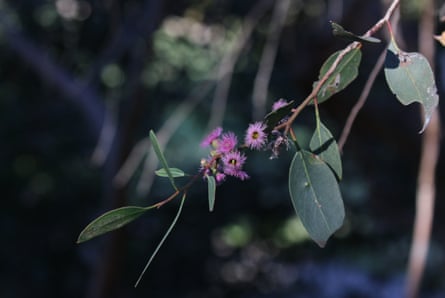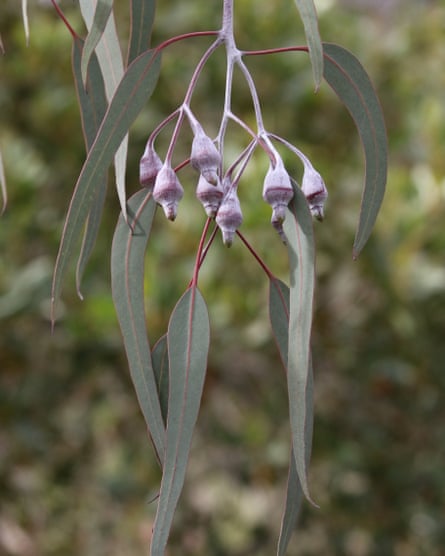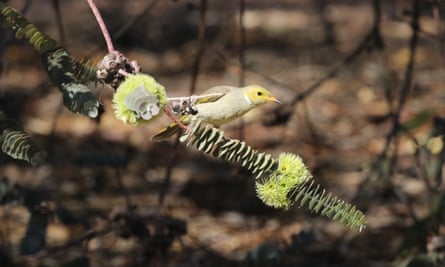As a teenager, Dean Nicolle dreamed of planting one of every eucalypt species in Australia. He took his parents to nurseries and requested that they buy “any eucalypt with a different name on it”. Nicolle, a self-described “gum nut” who is now a botanist and ecologist, has been fascinated by plants since he was eight.
On a plot of land at Currency Creek, an hour’s drive south of Adelaide, he set about creating his own arboretum. “The first plantings went in in 1992,” he recalls.
Today, Nicolle’s arboretum is comprehensive: it has more than 10,000 plants of more than 900 different species and subspecies of eucalypt.

Eucalypts are golden, literally: trees in South Australia and Western Australia have been found to draw up water containing gold and deposit the metal on their leaves and branches. They are blue, too: forests of the plants release compounds called terpenoids into the air, scattering light to give the Blue Mountains its characteristic haze.
And eucalypt flowers can be almost every colour conceivable: there’s the purple of the Port Lincoln mallee, the pale pink of the caesia (also known as the silver princess) and the fluorescent yellow of the book-leaf mallee.

“Eucalypts have fed obsessions, trailed questions, and leaned against each other in a pyre of ideas and images,” writes Ashley Hay in Gum: The Story of Eucalypts & their Champions, a new edition of which was published in November. “They have been grown, pulped, painted, written – and ignored.”
Each year, 25 species are chosen by Eucalypt Australia, a charitable trust, for a public Eucalypt of the Year poll.
“It’s primarily an awareness and education tool,” says Linda Baird, chief executive of the organisation.
Nicolle, who consulted on the poll, says narrowing down the list for voting was a tough ask.
“That’s really difficult when you’re talking over 900 different species of eucalypts.”
Voting in the 2022 competition opened this week. So which eucalypts have made the shortlist?
Not just the giants
Though the terms eucalypt, Eucalyptus and gum tree are often used interchangeably, they aren’t synonymous. Eucalyptus is a genus – a scientific category – of eucalypt. In Australia, plants belonging to the Eucalyptus, Angophora and Corymbia genera are known as gum trees – so called for the sticky substance, called kino, that many of the plants produce.
Whether in John Williamson’s twangy cover of Home Among the Gum Trees, or the ghost gums that feature prominently in the landscapes of Albert Namatjira, images of giant eucalypts loom large in the Australian consciousness.

As well as the ghost gum – which is also called ilwempe by the Arrernte people – other towering species in contention for Eucalypt of the Year include the mountain ash, which grows up to 100 metres high and is one of the tallest flowering plants in the world. There’s also the much-loved Sydney red gum, the lemon-scented gum and the messmate stringybark, a resilient species that gave rise to the term Eucalyptus.
But many eucalypts aren’t trees at all. More than 300 species are shrubs, and some are even pot-plant sized. “Eucalypts grow everywhere from your ankles to 100 metres high,” Baird says.

Of the smaller species featured in the voting list is the Mongarlowe mallee, the rarest eucalypt in Australia. There are only six individuals of the critically endangered species left – and they could be as old as 10,000 years.
Also known as the ice age gum, the Mongarlowe mallee is thought to be a relic of when conditions in Australia were wetter and cooler, Nicolle says.
Previous winners – river red gum, snow gum, red-capped gum/illyarrie and gimlet gum – are ineligible to win this year.

Existential threat
“Climate change would be by far the biggest threat to eucalypt species in general,” Nicolle says. “Even though they occur over most of Australia and a lot of different climatic conditions – from the mountains down to the sea – most eucalypt species are quite restricted in distribution.
“They’re only adapted to a very narrow climatic range, whether it be rainfall, soil type, temperature, or a combination of all those things.”
One example featured on the voting list is the endangered Morrisby’s gum. There are only a few thousand individuals found on two small hills near Hobart.
“Because the climate’s been drying there, particularly the winter rainfall over the last decade, the trees have been put under a lot more water stress,” Nicolle says. “Then you get other problems … they’re more susceptible to insect attack and also predation from possums.” As a result, mature trees start to die, without regeneration of new trees.
“[Eucalyptus] morrisbyi is just one example of that,” Nicolle says. “But that’s happening all over Australia, and particularly southern Australia, where winter rainfall is dropping off.”
The increasing frequency of bushfires is also an existential threat. Drive through some regions that have burnt in recent years, and you might see charred trees fluffy with new green growth.

This occurs because some eucalypt species have epicormic buds that lie dormant beneath the bark. “There’s a regulatory hormone in the crown [the top part of the tree], which stops the epicormic buds shooting normally,” Baird says. Damage such as by fire results in extensive sprouting and revegetation.
“Then other places you go to, the trees are dead,” Baird says. “They just don’t have this ability.”
Nicolle says: “There’s about 80 species that are killed by fire, so they only regenerate by seed.” This includes the mountain ash and the coral gum. For some species, regeneration to maturity takes decades.
“If you’re getting fires more often than the trees can seed, grow up again and flower and seed again, then they become locally extinct in an area,” he says.
Biodiversity benefits
Though eucalypts are evocative of the Australian bush, many species thrive in urban environments.
“People forget that there are a lot of smaller-growing species that are quite suitable for home gardens and for planning in parks,” Nicolle says.

He would like to see smaller eucalypts such as the octopus mallee, the coral gum and the Moon Lagoon mallee planted more in cities, over popular exotic trees such as Manchurian pears, plane trees and flowering cherries.
“While all of those [trees] are good trees, none of them have the biodiversity benefits that some of these eucalypts have in attracting native wildlife.”
Eucalypt of the Year voting is open until 20 March

Comments (…)
Sign in or create your Guardian account to join the discussion